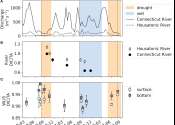Streetlights running all night makes leaves so tough that insects can't eat them, threatening the food chain
Light pollution disrupts circadian rhythms and ecosystems worldwide—but for plants, dependent on light for photosynthesis, its effects could be profound. Now scientists writing in Frontiers in Plant Science have found that ...









